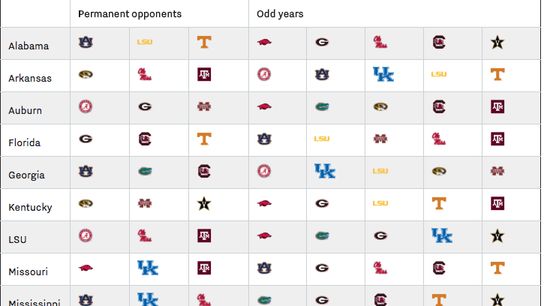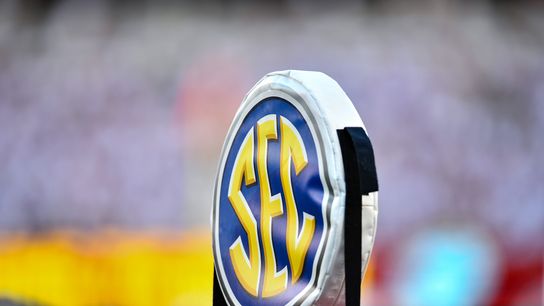Jeff Long went on the radio on Wednesday and lodged the same complaint may of his peers have.
Complaints such as these have been around for years, but they've intensified since the league's 2012 expansion. You usually hear them from the mouths of Auburn people -- Auburn AD Jay Jacobs has taken up the torch of late -- since they stand the most to gain from changing the status quo. And the status quo stinks. A 14-team league with 7-team divisions playing an 8-game schedule with a permanent inter-divisional crossover game leaves exactly one game a year open to change on a year-to-year basis. It's thanks to this system that Texas A&M and Georgia can allegedly compete in the same conference for 13 years before the Bulldogs actually visit College Station. That should not happen.
I replied to the above tweet stating that the solution was obvious, only to discover that, to people who aren't scheduling nerds like me, the solution isn't obvious at all. So here it is: eliminate divisions entirely and replace them by giving each team three permanent opponents and five rotating opponents.
This would solve a number of the SEC's problems in one fell swoop.
1) A 3/5 alignment would allow every SEC to cycle through the entire league roster within two years, and for every SEC team to host every single SEC opponent within four years. This means no Kentucky player will ever leave Lexington without playing in Bryant-Denny Stadium, and no Texas A&M student would ever get a Bachelor's degree without seeing Georgia come to Kyle Field -- as opposed to now, when an Aggie student could get a Bachelor's, a Master's and a Ph.D. without seeing the Bulldogs in person.
2) This would actually put the top two SEC teams in the SEC Championship, instead of the current set-up when Alabama (or whoever happens to win the West) plays the fourth- or fifth-best team that happened to win the East. (And, to be sure, this cycle worked in reverse in the '90's, when Florida and Tennessee ran laps around the West.) The boom-bust cycle of divisional strength would be eliminated completely.
Confused? Let's play out how it would work in real life!
Let's take, for example, Alabama. The Crimson Tide would play Auburn, Tennessee and LSU annually. With 13 teams to schedule -- you can't play yourself, remember -- this leaves 10 teams to play on a rotating basis. Alabama could play South Carolina, Florida, Vanderbilt, Arkansas and Texas A&M in even-numbered years, and Ole Miss, Mississippi State, Kentucky, Missouri and Georgia in odd-numbered years. Home-and-away would flip-flop as it does now.
If and when Alabama objects that its three permanent opponents are too difficult, the SEC could respond:
A) You play Auburn, LSU and Tennessee on an annual basis right now, and have for decades. If anything this makes your schedule easier than it is today.
B) This is why you're 'Bama.
How would this work for the rest of the league? Thankfully, SB Nation has already done the hypothetical legwork and laid it all out in this handy chart.

To make any omelet you have to crack a few eggs, and there would be some schools upset about the hypothetical set up you see above. Kentucky would rather play Tennessee annually than Mississippi State, and Arkansas would prefer to see LSU every year instead of Ole Miss. But there are winners and losers to every system -- ask Auburn and Florida old-timers how they feel about seeing their once annual series now being played once every seven years -- and even the losers in this system still get to see their preferred opponents every other year at worst.
There's nothing novel being discussed here. If the dorks that write for a couple football websites could figure this stuff out, surely the highly-paid professionals that actually run the SEC and its member schools could do the same.
But they haven't, and I suspect there are two reasons why:
1) "It's the way we've always done it." This flawed but powerful line of reasoning keeps flawed systems in place for years, decades and millennia all across humanity. Next time you go to Grandma's for Thanksgiving, ask her to change the way she bakes the turkey and you'll see how powerful tradition-for-tradition's-sake really is.
2) The SEC doesn't actually want to see its top two teams meet in Atlanta. The league would have much more to lose by seeing its 1 vs. 2 meet for the conference championship than, say, 1 vs. 5. And it's tough to blame them. The Big 12 watched in agony over the years as an entire handful of national title contenders crashed and burned on the first Saturday of December, and the SEC has been fortunate to avoid that fate. Some of that is sheer luck, and some of it simply the league building in protections for its top team. The Big 12 brings its championship game back this season, and when No. 10 Oklahoma State avenges its regular season loss to No. 4 Oklahoma in the Big 12 title game -- knocking the conference out of the College Football Playoff in the process -- you'll see why the SEC is happy with its current alignment.
